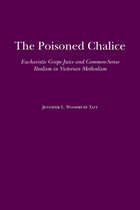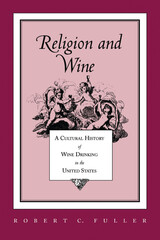2 books about Temperance and religion

The Poisoned Chalice
Eucharistic Grape Juice and Common-Sense Realism in Victorian Methodism
Jennifer L. Woodruff Tait
University of Alabama Press, 2011
Examines the introduction of grape juice into the celebration of Holy Communion in the late 19th century Methodist Episcopal Church and reveals how a 1,800-year-old practice of using fermented communion wine became theologically incomprehensible in a mere forty years
This work examines the introduction of grape juice into the celebration of Holy Communion in the late 19th century Methodist Episcopal Church and reveals how a 1,800-year-old practice of using fermented communion wine became theologically incomprehensible in a mere forty years. Through study of denominational publications, influential exegetical works, popular fiction and songs, and didactic moral literature, Jennifer Woodruff Tait charts the development of opposing symbolic associations for wine and grape juice. She argues that 19th century Methodists, steeped in Baconian models of science and operating from epistemological presuppositions dictated by common-sense realism, placed a premium on the ability to perceive reality accurately in order to act morally. They therefore rejected any action or substance that dulled or confused the senses (in addition to alcohol, this included “bad” books, the theatre, stimulants, etc., which were all seen as unleashing unchecked, ungovernable thoughts and passions incompatible with true religion).
This work examines the introduction of grape juice into the celebration of Holy Communion in the late 19th century Methodist Episcopal Church and reveals how a 1,800-year-old practice of using fermented communion wine became theologically incomprehensible in a mere forty years. Through study of denominational publications, influential exegetical works, popular fiction and songs, and didactic moral literature, Jennifer Woodruff Tait charts the development of opposing symbolic associations for wine and grape juice. She argues that 19th century Methodists, steeped in Baconian models of science and operating from epistemological presuppositions dictated by common-sense realism, placed a premium on the ability to perceive reality accurately in order to act morally. They therefore rejected any action or substance that dulled or confused the senses (in addition to alcohol, this included “bad” books, the theatre, stimulants, etc., which were all seen as unleashing unchecked, ungovernable thoughts and passions incompatible with true religion).
This outlook informed Methodist opposition to many popular amusements and behaviors, and they decided to place on the communion table a substance scientifically and theologically pure. Grape juice was considered holy because it did not cloud the mind, and new techniques—developed by Methodist laymen Thomas and Charles Welch—permitted the safe bottling and shipment of the unfermented juice.
Although Methodists were not the only religious group to oppose communion wine, the experience of this broadly based and numerous denomination illuminates similar beliefs and actions by other groups.
[more]

Religion And Wine
Cultural History Wine Drinking United States
Robert C. Fuller
University of Tennessee Press, 1996
Wine, more than any other food or beverage, is intimately associated with religious experience and celebratory rituals. Nowhere is this seen more clearly than in American cultural history. From the Pilgrims at Plymouth Rock to the Franciscans and Jesuits who pioneered California's Mission Trail, many American religious groups have required wine to perform their sacraments and enliven their evening meals. This book tells the story of how viniculture in America was started and sustained by a broad spectrum of religious denominations. In the process, it offers new insights into the special relationship between wine production and consumption and the spiritual dimension of human experience. Robert Fuller's historical narrative encompasses a fascinating array of groups and individuals, and the author makes some provocative connections between the love of wine and the particularities of religious experience. For example, he speculates on the ways in which Thomas Jefferson's celebrated knowledge of wine related to his cultural sophistication and free-thinking outlook on matters of religion and spirituality. Elsewhere he describes how a number of nineteenth-century communal groups-including the Rappites, the Amana colonies, the Mormons, and the spiritualist colony called the Brotherhood of the New Life helped to spread the religious use of wine across a vast new nation. Fuller describes and analyzes the role of wine drinking in promoting community solidarity and facilitating a variety of religious experiences, ranging from the warm glow of ritualized camaraderie to the ecstasy of immediate contact with otherwise hidden spiritual realms. He also devotes a chapter to the rise of temperance and prohibitionist sentiments among fundamentalist Christians and their subsequent attack on wine drinking. The book's concluding chapter features an insightful analysis of the ritual dimensions of contemporary wine drinking and wine culture. According to Fuller, the aesthetic experiences and communal affirmation that some religious groups have historically associated with the enjoyment of wine have passed into the practice of popular-or "unchurched"-religion in the United States.
[more]
READERS
Browse our collection.
PUBLISHERS
See BiblioVault's publisher services.
STUDENT SERVICES
Files for college accessibility offices.
UChicago Accessibility Resources
home | accessibility | search | about | contact us
BiblioVault ® 2001 - 2024
The University of Chicago Press









